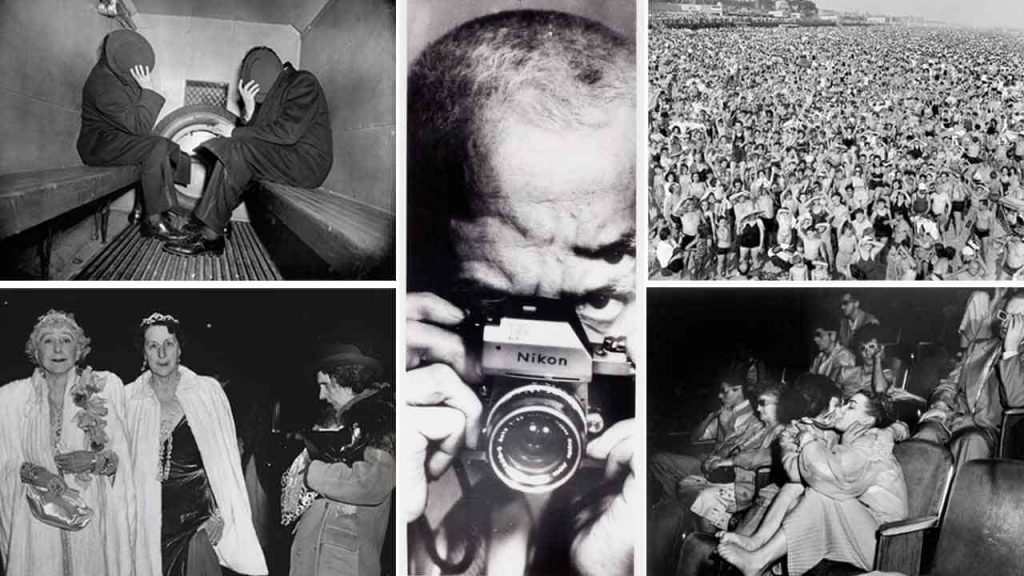No other photographer came close to capturing the sensations, gruesome murders, scandals, and catastrophes of New York City in the 1930s and 1940s like Weegee did.
Unique and immediately recognizable, his work stands alone in the history of photography. His greatest photos have an unsettling beauty and the power of images which, once seen, are never forgotten.
He earned his nickname, Weegee because he would often arrive at the scene of a crime or disaster only minutes after they were first reported.
Armed with his trusty Speed Graphic camera and a police radio, Weegee often beat the police to the story. He even had a darkroom in the trunk of his car, so he could get his photos to the sensation-hungry tabloids as quickly as possible.
In time the name Weegee became legendary, descriptive of a different kind of photo: one that captured the exciting drama of life. Concerned more with the impact of his images than with artistry, Weegee favored irony and sarcasm with a touch of compassion in his work.
Weegee’s career is unusual in that he was both successful in the popular media and respected by the fine-art community during his lifetime.
In this article, we’ll aim to provide a basic overview of Weegee’s photography career and remarkable work. If you find the article helpful, then we would be grateful if you could share with others on social media, or photography forums.
Related: 35 Weegee Quotes: Timeless and Practical Photography Lessons
It’s like a modern Aladdin’s Lamp, you rub it and, in this case, the camera, you push the button and it gives you the things you want. News photography teaches you to think fast, to be sure of yourself, self-confidence. When you go out on a story, you don’t go back for another sitting. You gotta get it.
Weegee
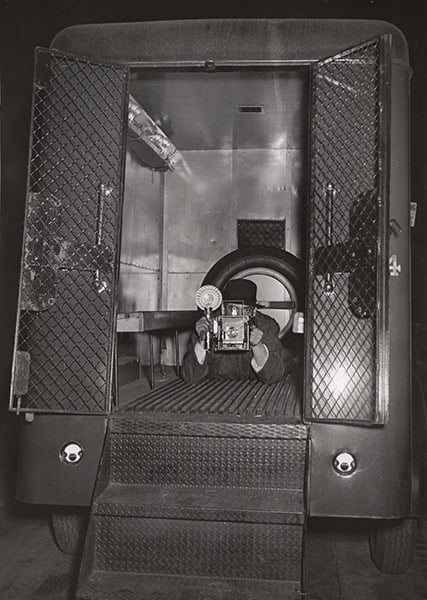
Table of Contents
Weegee Biography
Name: Arthur Fellig (Born Usher Fellig)
Nationality: American/Austrian
Genre: Photojournalism, Street, Crime, Experimental
Born: June 12 ,1899 (Zolochiv, Austria)
Died: December 26, 1968 (New York City)
Early Life
Usher Fellig, later known as Weegee, was born on June 12, 1899, in the village of Zolochiv, Austria (now in Ukraine).
Ten years later, with his mother and three brothers, he arrived in New York City to join his father, who had settled earlier to earn the money for their passage. At Ellis Island, an immigration officer changed his name from Usher to Arthur.
The Fellig family settled on New York’s Lower East Side, and Arthur was put into school with no English at his command, though he learned fairly quickly.
Although a dedicated student, by the time he landed in the eighth grade, he decided to leave school to find a job to support his family. Whatever money he could earn the family needed: his father, unskilled at pushcart bargaining, had turned poor rabbi.
Arthur took to the streets for his livelihood. Among his jobs in the next few years were candy butcher at burlesque houses, a photographer of kids sitting on a rented pony (named Hypo) for tintypes, and even a stint as a dishwasher at the Automat.
In 1918, he began working as an assistant at Ducket and Alder photography studio. Then in 1921, he found a position as a darkroom technician working in the darkrooms of the New York Times.
Photography Career
In 1924, he joined ACME News Pictures (which would later become UPI Photos) and began filling in on photographic assignments when other staff photographers were unavailable. During his time with ACME, Fellig left home in order to free himself of his family’s orthodox ways.
In late 1935, after many years of frustration due to the lack of recognition for his work, and not having his name on photographs, he left ACME and became a freelance news photographer in his own right.
Over the course of the next 12 years, Weegee would shoot some of the most memorable images ever taken of New York.
Weegee captured the good, the bad, and in particular the ugly, with remarkable sensitivity. With his trademark Speed Graphic, he managed to capture in detail both the ordinary and the extraordinary in a city he clearly loved and understood.
His gritty pictures of New York life – the opposite to his contemporaries whose style often romanticized the hard times which many endured – have become part of the visual vocabulary through which we understand the period.
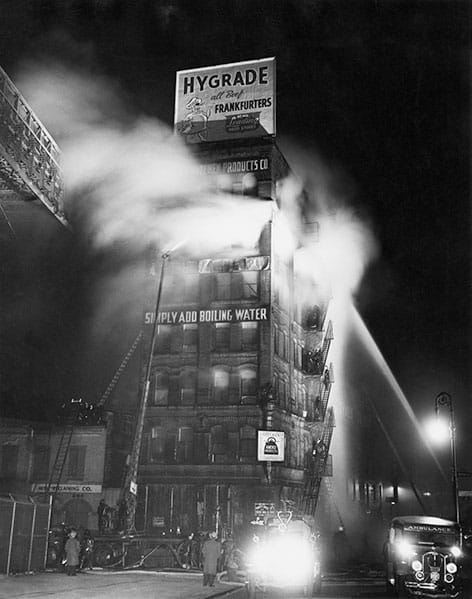
Police Radio
During the mid-30s, Weegee centered his practice around police headquarters, and in 1938 he installed a short wave police radio which, when it wasn’t in his car, was stationed by his bedside.
Sanctioned by the New York Police Department, Weegee would listen day and night to the emergency calls being reported over the radio by the NYPD and if any piqued his interest he would immediately jump into his car and make his way to the scene.
Needless to say, Weegee would usually be the first photographer to arrive at any newsworthy incident and would, in the process, often beat the police to the scene of the crime.
My car became my home. It was a two-seater, with an extra-large trunk. I kept everything there, an extra camera, flashlight bulbs, a typewriter, firefighter boots, cigar boxes, salami, infrared film to shoot in the dark, a change of underwear, uniforms, costumes, and extra shoes and socks. (…) Since then I was no longer attached to the teletype of the police headquarters. I had wings. I no longer had to wait for the crime to come to me; I could go after him. [The] Police radio was my way of life. My camera… my life and my love… was my Aladdin lamp.
Weegee
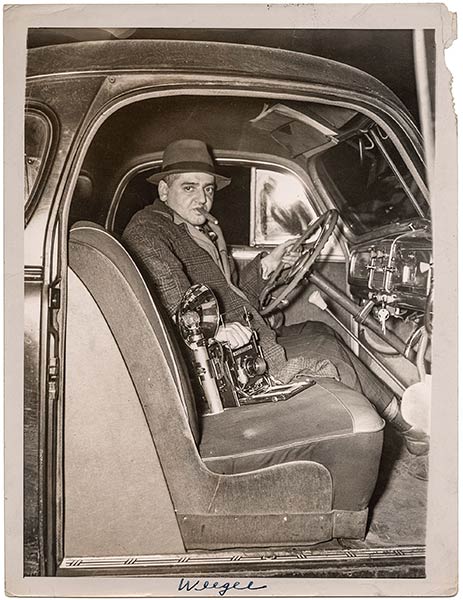
Becoming Weegee
It is a matter of speculation as to how and when Fellig became known as Weegee, though it is generally accepted as being 1938, the same year he started using the police radio.
According to legend, cops asked him if he had a Ouija board due to his clairvoyant ability to be in the right place at the right time. From this came the onomatopoeic word Weegee.
The reality is that it was Fellig himself who created the catchy pseudonym of Weegee as an act of self-promotion. In 1940, in another act of self-publicity, he began stamping his prints “Weegee the Famous”.
Finding His Subjects
In the 12-year period between 1936 and 1948, Weegee covered over 5,000 murders, went through five cars, and had worn out 10 plate cameras.
Ironically, given his specialism in photographing gruesome and often bloody, murder scenes, Weegee was a rather squeamish and hated the sight of blood, but as he once remarked, he was ‘‘spellbound by the mystery of murder.’’
Not all of his photos were of crime and death though. When it came to finding his stories he was more interested in those that would make the front pages of the tabloids:
And naturally, I picked a story that meant something, in other words, names make news. If there’s a fight between a couple on 3rd avenue or 9th avenue in Hell’s Kitchen, nobody cares, it’s just a bar-room brawl. But if society has a fight in a Cadillac on Park Avenue and their names are in the Social Register, this makes news, and the papers are interested in that.
Weegee
Other Photographs
In 1941, Weegee stood atop a lifeguard’s station in Coney Island and captured a picture of a gigantic crowd of bathers, all looking up to him (he yelled out at the top of his voice to get their attention). This crazy scene, captured one hot summer day in July became one of his most famous photographs.

In the mid-1940s, armed with his camera and infrared film, he photographed movie-goers in New York cinemas and produced a moving series of embracing couples, mesmerized kids, and exhilarated teens.
The Critic
Weegee took his most famous picture The Critic in 1943. The picture shows two fur-draped, tiara-ed matrons playing to the camera while a scruffy, disturbed-looking woman stands in profile to the side.
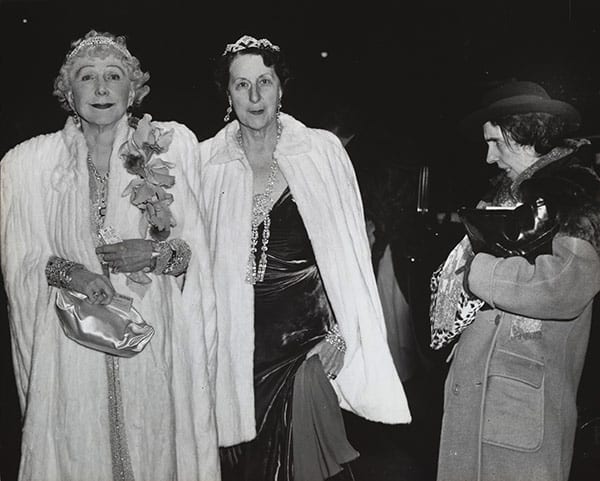
In an excerpt from the book, Weegee’s Secrets of Shooting with Photoflash (recommended purchase) Weegee explains what he likes to call his “masterpiece picture” in more detail:
People always ask me, “What is the best picture you ever took?” Without hesitation, I answer, “A picture I took at the opening of the Metropolitan Opera House.” I consider this to be my masterpiece.
Let me tell you a little about the story of the picture. The crime teletype machine was quiet at police headquarters… so I decided to go to the opening of the Opera. The Rolls-Royces, big and shiny, kept arriving. This was a big night for the photographers… the flashbulbs went off like fireworks on the Fourth of July. It was a cold night, and al the cameramen, including myself, were lined up inside the lobby taking posed shots of the socialites. I did this for a while… got bored… and decided to go outside to see if I could catch something different.
The Rolls-Royces kept on coming, out of one of them emerged two ladies. My flashbulb popped, and… the result… a picture that appeared in practically every newspaper and magazine throughout the world… was bought by the New York Museum of Modern Art… and is still being exhibited by museums throughout the country… a study in contrast.
Weegee
The image didn’t come through chance as Weegee would have you believe…
Not averse to orchestrating a shot, he sent his assistant, Louie Liotta, to a Bowery nightspot in search of a drunk woman. Liotta found a willing subject and took her to the Opera House.
Liotta placed the woman near the entrance while Weegee watched for the arrival of Lady Decies and Mrs. George Washington Kavanaugh (two women who regularly graced society columns).
When the woman arrived, Weegee gave Liotta the signal to spring out at the drunk woman. Liotta would later recall, “It was like an explosion. I thought I went blind from the three or four flash exposures.”
With that flash, Weegee captured a contrasting image of wealth and dire poverty in one frame.
The fact that The Critic was later revealed to have been staged did little to dampen the popularity of the picture with TIME selecting it as one of the 100 most iconic photos of all time.
Naked City and Celebrity Status
During the 1940s, Weegee’s photographs appeared outside the mainstream press. In 1941, New York’s Photo League held an exhibition of his work, and in 1943, the Museum of Modern Art began collecting and exhibiting his work.
His celebrity status came shortly after the release of his first book Naked City, which was published in 1945. Naked City quickly established Weegee into a media star. The book would later spawn the feature film The Naked City, and a hit television show.
With his rise in popularity, Weegee abandoned crime photos and concentrated on the more lucrative side of the photography business, shooting advertising assignments for the likes of Vogue, Life, Look, and Holiday.
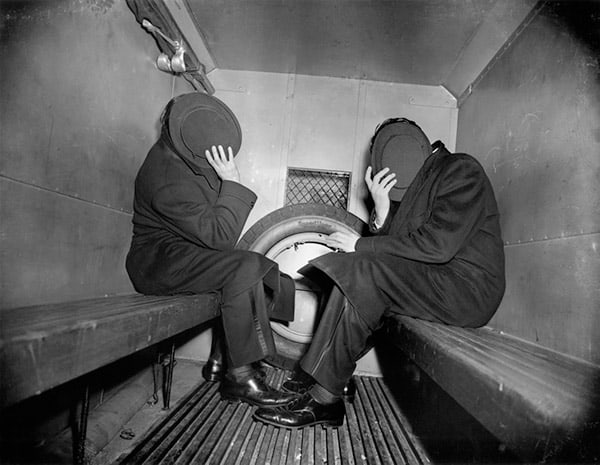
Hollywood Years
Weegee moved from New York to the west coast and lived in Hollywood from 1947 to 1952, primarily working as a film consultant but also playing cameo roles in a number of films.
His screen credits include Every Girl Should be Married (1948), The Set-Up (1949), The Yellow Cab Man (1950), and Journey into Light (1951).
His most famous part, essentially playing himself, was as a street photographer in Universal’s noir film The Naked City (1948).
Weegee’s last major Hollywood assignment came in 1958 when Stanley Kubrick (an admirer of his work) invited him to take stills on the set of Dr. Strangelove. The stills Kubrick wanted weren’t the type that anyone could take, those were left to Columbia’s in-house photographers.
Stanley says to me, “Look, all the photographers nowadays, they’re using available light,” and so forth. He doesn’t quite like it. He’s a nut on sharp pictures. He says, “Weegee, when you make pictures for Naked City they were very crude. You had the flashbulb right on the camera. This is… If you took pictures like this nowadays they’d laugh at you. But I want it like that.” So you’ll notice I’m the only one that makes flash pictures. I don’t have to actually. But I do it to make Stanley happy.
Weegee
Weegee’s influence on the film would go beyond publicity stills. After 3 months of observing Weegee on set, the film’s star Peter Sellers, found him fascinating, as anyone obsessed with accents and eccentricities would, and decided to model Dr. Strangelove’s high-pitched German accent on the photographer.
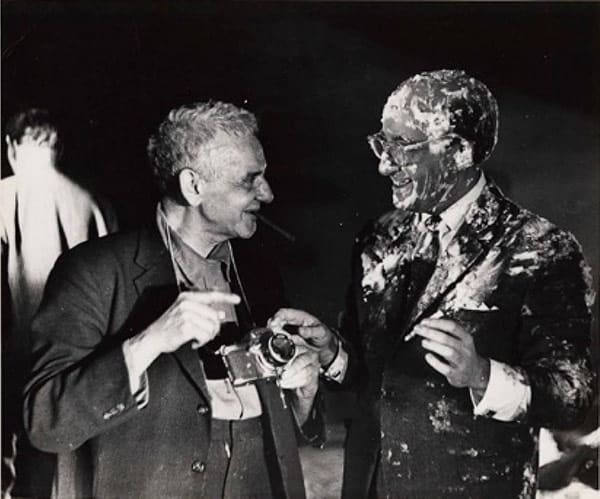
Distortions and Experimental Photography

Whilst in Hollywood, Weegee began a series of photo-distortions of celebrities and politicians using a variety of homemade kaleidoscopic lenses, mirrors, and other distorting apparatus.
In Marilyn Monroe Distortion, Weegee uses a kaleidoscope lens to manipulate a portrait he took of Marilyn Monroe. The distortion from the kaleidoscope scrunches the iconic beauties facial features: making her lips appear smaller, morphing her nose into a pig’s snout, and elongating her closed eyes.
Weegee’s other distorted subjects (or victims) include Richard Nixon, Pablo Picasso, and John F. Kennedy, amongst others.
Artist Andy Warhol not only admired Weegee’s distorted images, but he even used them in his own work. Today, Weegee’s experimental images are recognized as an important precursor to the Pop art movement of the 1950s and ’60s.
In later years, Weegee continued his experimental and abstract photography work, as well as completing several short films such as Manhattan Moods (1946), Weegee’s New York (1948), Cocktail Party (1950), and The Idiot Box (1965).
Later Career
Weegee returned to New York in 1952, although he spent most of his later years working in Europe as both a freelance photographer and lecturer.
During his lifetime, Weegee published several books. After the success of Naked City in 1945, he released Weegee’s People a year later.
Though Weegee’s People was a success in terms of sales, it was becoming clear that the many years of working as a news photographer had taken their toll on the photographer – he no longer seemed to possess the hunger and desire to shoot murders, accidents, and scenes of disorder as he once had. It would be another seven years before his third publication Naked Hollywood in 1953.
Naked Hollywood was met with poor critical reception since it contained many of his photo-caricatures and distortions, a style of photography the world wasn’t ready for yet. Opinion on his experimental work softened a little years later when Vogue published a number of his abstract portraits in 1955.
While in London in the early 1960s, Weegee became friends with fellow photographer George Harrison Marks and glamour model, Pamela Green. In 1966, just two years before his death, he starred in a nude exploitation film called The Imp’probable Mr. Wee Gee. The film was intended to be a pseudo-documentary of his life, in which Weegee (playing himself) falls in love with a store mannequin and travels to Paris and London.
Personal Life and Final Years
Weegee married only once in his life to Margaret Atwood in 1946. The marriage didn’t last long and they separated three years later, finally divorcing in 1950. Weegee never remarried, although his long time friend (since the early 1940s) Wilma Wilcox remained his close companion until his death.
Weegee’s died in New York on 26 December 1968 at the age of 69. After his death, Wilma continued to promote his work and was chiefly responsible for keeping the Weegee legacy alive.
When Wilma died in 1993, she bequeathed her entire collection of original prints, negatives, letters, and Weegee’s personal effects to the ICP ( International Center of Photography) in New York. In 1998, the ICP held a Weegee retrospective exhibition.
In the 1992 film Public Eye, Joe Pesci stars as a fictionalized press photographer loosely based on Weegee. Howard Franklin (the director) was unable to secure the rights to Weegee’s life story, so he created a fictionalized version for the film. The crime thriller, which is set in 1940s New York, includes some of Weegee’s crime photographs.
Weegee’s Style
- Gritty black-and-white
- Candid, Sense of Immediacy
- Street, Voyeuristic
- Contrasting elements, Irony
- Harsh lighting, use of flash
What Camera Did Weegee Use?
When it came to camera gear, Weegee liked to keep it simple…
He always used the same camera and lens, and most of the time, the same exposure:
- 4×5 Speed Graphic Camera
- 127mm Kodak Ektar Lens (equivalent to 42mm in 35mm)
- Graflex flash synchronizer
He developed a standard set up when shooting which gave his images maximum tonality and magnified sharpness – he stopped the lens down to the aperture of f/16, set the shutter speed to 1/200th second, and stood 10 feet from his subject.
The only camera I use is a 4×5 Speed Graphic with a Kodak Ektar Lens in a Supermatic shutter, all American made. The film I use is a Super Pancro Press Type B.
I always use a flashbulb for my pictures which are mostly taken at night. Even on the few occasions where I have made shots by daylight, I still use a flashbulb. I also use a Graflex flash synchronizer and the exposure is always the same, 1/200 part of a second stop F.16, that is, at a distance of ten feet.
When I am making close-ups at six feet, with the light from the flashbulb closer to the subject and hence stronger, I step down to F32, which compensates if I am a little off in my guess of the distance.
Weegee
Later on in his career, Weegee would experiment with different 35mm cameras (including Leica and Nikon).
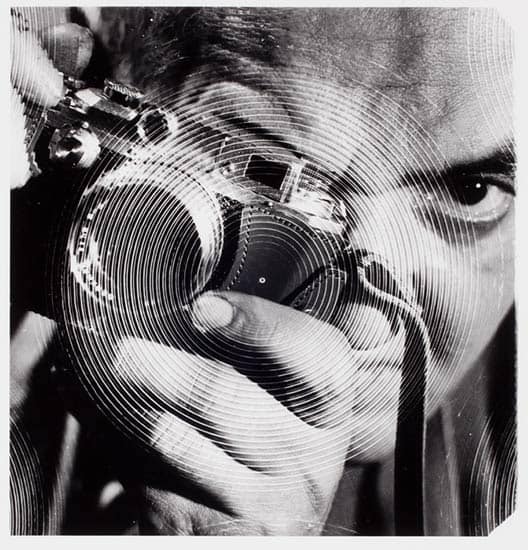
How to Shoot Like Weegee
When it comes to Weegee’s technique, he usually worked without a preconceived idea of composition, with his use of flash a key element – the flash tended to frame the subject for him and eliminated unwanted background detail.
Weegee would often shot his images in the middle of the night, in complete darkness. As a result, he wasn’t always 100% sure what he captured. He would only discover what he got on film once he processed his images.
MCBRIDE: I should think when you are taking pictures, you’re oblivious. You don’t really know what else is going.
WEEGEE: Oh absolutely not. I just look through the wire-finder in my camera and as a matter of fact, when I really see the picture is when I’ve developed the film. Then I really see what I’ve have done.
Weegee, Interview with Mary Margaret McBride, 1945
Weegee then explains that he is often caught up in the moment when out shooting in the field:
I really seem to be in a trance when I am taking the picture because there is so much drama taking place or will take place. I mean, you just can’t hide it – go around wearing rose-colored glasses. In other words, we have beauty and we have ugliness. Everybody likes beauty, but there’s an ugliness. When people look at these pictures of people sleeping on the fire escapes, and kids and little girls holding cats, they just won’t believe a thing like that has happened.
Weegee
Weegee’s Tips for Better Photography
Below are a few excerpts on photography technique from Weegee’s books Naked City and Secrets of Shooting with Photoflash.
If you’re interested in learning more about Weegee’s photography methods then I highly recommend purchasing both books.
Photography Technique
In the past twenty-two years, I have taken about ninety-eight percent of my pictures with flash. Practically all were unposed. Mind you, I’m not saying the only good pictures are candid ones. Far from it… some of the most beautiful pictures in the world are posed… but the only pictures that I like to take are the ones that catch and preserve the movement of life.
I have always been asked, “Weegee, how do you manage to get that lifelike quality in your pictures?” “Very simply,“ I’d reply. “I see a good picture and I snap it.”
Weegee
The Qualities of a Good Photograph
Let’s spend a moment on the qualities of a good photograph.
These vary with the type and purpose of the photo… there are passport, medical, industrial photos, etc… all intended to do a specific job. A passport photo, for instance, should merely identify someone… it would be foolish to judge it by any artistic standards.
Another type is the “salon” [studio] print, as it is called. Here the important factors are print quality, the proper relationship of light and shadow, composition, etc. The purpose of this type is decorative and certainly has a place in the modern home.
However, [my type of photography] captures a dramatic moment in life. It does the impossible by making time stand still… it freezes an emotion, an event… on film. It’s as if you reached out and caught the very breath of life and preserved it for all time. Most wonderful of all, it has the power to recreate the entire emotional experience many years later.
Incidentally, light, shadow, and composition are of secondary importance here. This doesn’t mean that the photo may not have these qualities… as a matter of fact as you progress, you’ll instinctively frame your picture so that a good composition is achieved.
The Secret Ingredient: Attitude
There’s one more secret ingredient that should go into a photo – ATTITUDE… this makes the difference between an ordinary photograph and a great one.
In all my lectures and magazine articles, I always [state] this point. Now just what is this thing called attitude? You can’t buy it. It doesn’t come wrapped in a package. Yet, without it, it is impossible to produce a picture that has life.
Actually, your attitude is a combination of many things. For one thing, you’ve got to love what you’re doing. You just can’t take a good picture with a ‘let’s get it over’ attitude.
Good photographs, like good paintings, must be carefully thought out. For another, you’ve got to be relaxed. A nervous photographer not only misses the good pictures but also upsets the subject, so, be at ease… especially in handling the camera.
Weegee
Contrast and Irony
A picture of a tramp sitting on a park bench can be very interesting… sometimes. This also applies to a picture of a man in high hat and tails. But-snap them both on the same park bench, and you have one of the most forceful, ironical features in photography… contrast.
Everything in life is placed against a background like a stage setting. An accident, an event, does not exist in a vacuum… isolated from everything around it. Then don’t treat it that way… don’t concentrate on just the subject alone.
When you come to a scene you want to photograph, look all around, notice everything. See if there is one thing against which the subject may be photographed that will give punch to the whole picture.
Often this can be achieved by actually walking all around the subject, whatever it is, looking at it from every possible perspective, and viewing the subject in relation to the background. You may turn an ordinary picture into a top one.
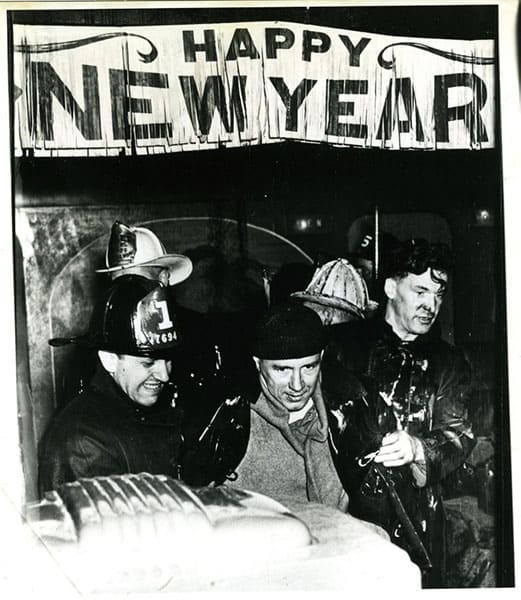
Zone Focusing
Guess focus troubles a lot of beginners, but on a story where lots of things are happening fast and furiously, one has no time to look through the ground glass to focus… or even to use the range finder… and besides, it is pitch dark.
I keep my camera set at ten feet, which takes care of most pictures. For close-ups quickly change the focusing scale to six feet by the light of a small pencil flash-light which I always carry with me. With concentration on six and ten feet and a lot of practice, one can guess these two distances.
Don’t try to guess focus the markings in the scale… no one can do that.. just practice six and ten feet, but do your practicing at home at your leisure… you won’t have time on a story. Editors demand and expect to get needle-sharp photographs.
Captions and Copy
Captions are important too. Editors want to know: who, when, and where. Get all the information you can, don’t be afraid to ask questions… be curious.
The readers always are, and even a guy who has just committed murder will give his name and address… and often try to justify his crime.
What I see and feel deeply I photograph and then I write down what I have noticed and felt.
I had never done any writing until the editor of PM, Ralph Ingersoll, heard me wisecracking at the city desk about a story I had shot and asked me to give him some copy to go with the pictures. At first, I was scared, but I sat down to a typewriter and finally found words for what I had seen and felt. That’s all there was to it.
Weegee
Selling Your Images
There is one last question which really needs no answer, but I hear it again and again. What pull does one need to be able to sell pictures? You don’t need any.
Editors buy pictures on their merit and their timeliness. You can best approach the problem of selling your work by studying the papers and magazines to see how other photographers handle any given story. Figure out how you would have covered it yourself.
Remember… the field is wide open. Be original and develop your own style, but don’t forget above anything and everything else… be human… think… feel.
When you find yourself beginning to feel a bond between yourself and the people you photograph when you laugh and cry with their laughter and tears, you will know you are on the right track… Good luck.
Weegee
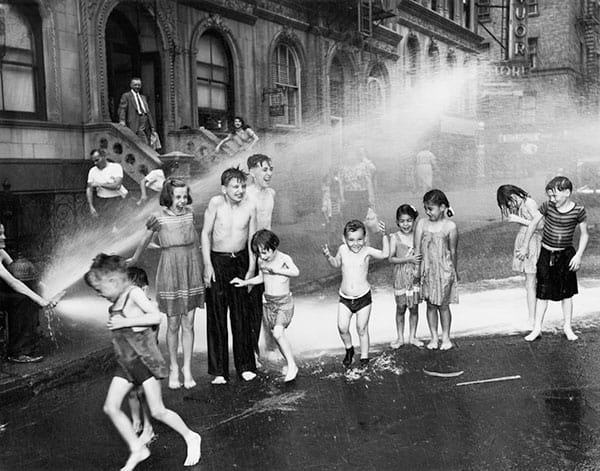
Other Resources
Recommended Weegee Books
Disclaimer: Photogpedia is an Amazon Associate and earns from qualifying purchases.
- Weegee’s Naked City (2020)
- Extra! Weegee (2017)
- Weegee’s New York: Photography 1930-1960 (2000)
- Weegee: The Autobiography (2016)
Weegee Videos
The Real Weegee Documentary (1993)
Weegee Tells How (Rare Interview, 1958)
In this rare interview, Weegee provides tips for becoming a better photographer and his techniques for finding images. The interview is also available online as an audio file at the Internet Archive.
Weegee Photos

Special, Pantys 39¢ © Weegee Archive/ICP 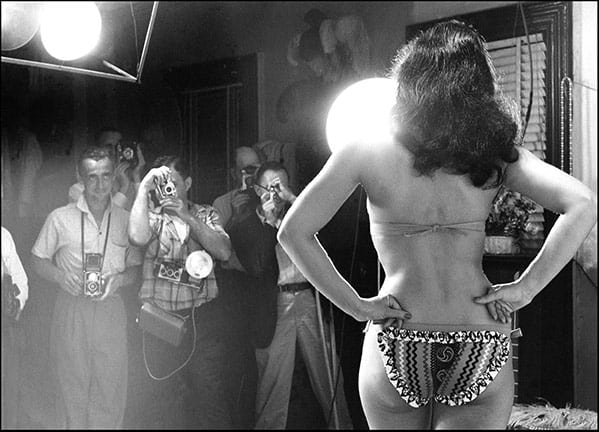
Bettie Page© Weegee Archive/ICP 
Under the Third Avenue Elevated, 1938 © Weegee Archive/ICP 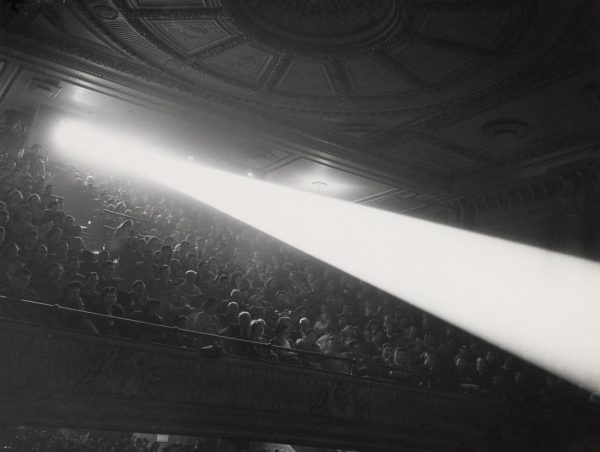
© Weegee Archive/ICP 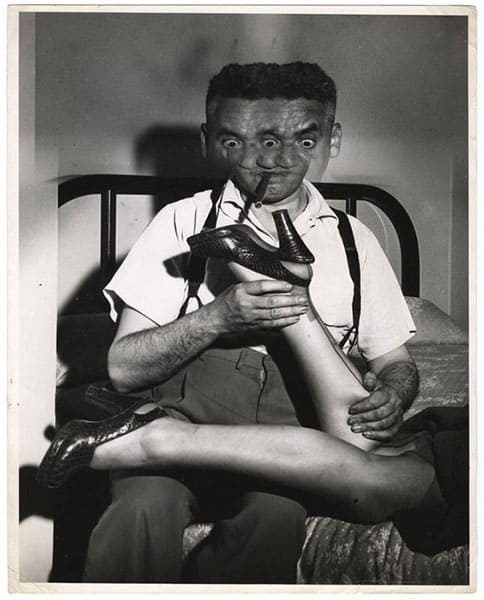
Talent Scout © Weegee Archive/ICP 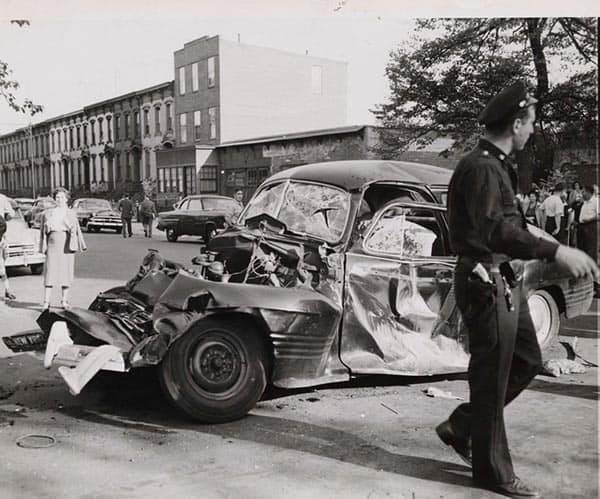
Car and truck collision in Brooklyn’s Stuyvesant Avenue, 1947 © Weegee Archive/ICP 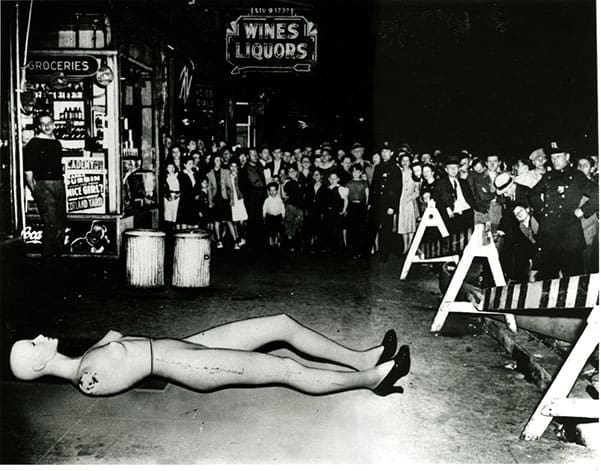
Unusual Crime (circa 1940) © Weegee Archive/ICP
View Weegee’s photos online for free at the International Centre of Photography (ICP)
Further Reading
Weegee the Famous, the Voyeur and Exhibitionist
Looking Through the Lens of Weegee
Mary Margaret McBride Interview with Weegee (1945)
Fact Check
With each Photographer profile post, we strive to be accurate and fair. If you see something that doesn’t look right, then contact us and we’ll update the post.
If there is anything else you would like to add about Weegee’s work or his life then send us an email: hello(at)photogpedia.com
Link to Photogpedia
If you’ve enjoyed the article or you’ve found it useful then we would be grateful if you could link back to us or share online through twitter or any other social media channel.
Finally, don’t forget to subscribe to our monthly newsletter, and follow us on Instagram and Twitter.
Sources
Weegee Profile, Michael Hoppen Gallery
100 Photographs, Weegee: The Critic, Time Magazine
Weegee Profile, International Centre of Photography
Interview with Mary Margaret McBride, 1945
Secrets of Shooting with Photoflash, Designers 3, 1953
Weegee, Aperture History Photography, 1978
Encyclopedia of Twentieth-Century Photography, 2005
Weegee: The Autobiography
Extra! Weegee, Hirmer, 2017
Flash: The Making of Weegee the Famous, Henry Hold Co, 2018
Naked City (Reproduction), Damiani, 2020
Weegee Tells How, Audio Interview, 1958
The Real Weegee Documentary, 1993

